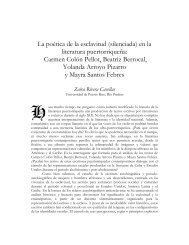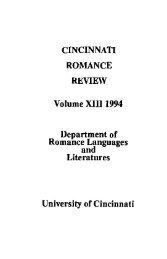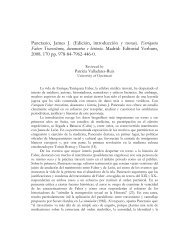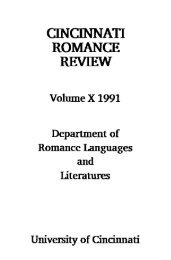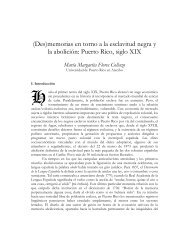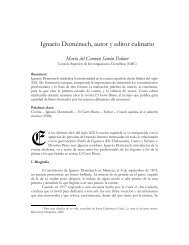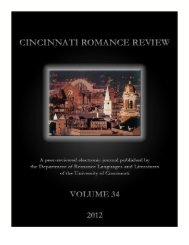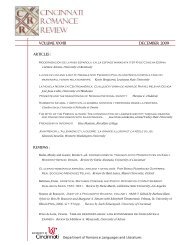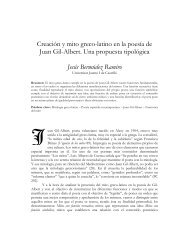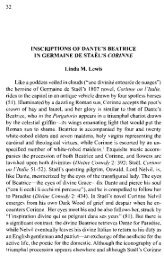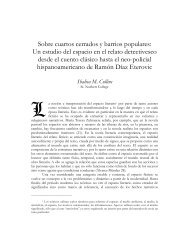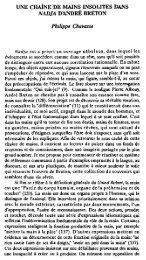Volume 30 (2011) - Cincinnati Romance Review
Volume 30 (2011) - Cincinnati Romance Review
Volume 30 (2011) - Cincinnati Romance Review
You also want an ePaper? Increase the reach of your titles
YUMPU automatically turns print PDFs into web optimized ePapers that Google loves.
118 DOSINDA GARCÍA ALVITE<br />
its way from Greece to Equatorial Guinea it undergoes a process of transculturation<br />
that needs to be examined. The commonality of the argument and characters should not<br />
distract the reader from paying attention to how those elements are being transposed to<br />
a new cultural context, and how other themes surge directly bound to the specific<br />
locality it is addressed to. One specific element constitutes an Afro-centric and<br />
womanist contribution and stands out in the process of reinterpretation of this classical<br />
drama: the importance of drums and dance to promote dialogue among the community<br />
members--both within the play and amongst the audience. The play’s emphasis in<br />
aspects that actively represent the culture of Equatorial Guinea indicates that Morgades<br />
Besari has done a conscious adaptation and transculturation of the classic drama.<br />
Why Antigone?<br />
The protagonist Antígona is in this play a sign of vitality, intelligence, search for<br />
fulfillment and the ability to stand up against pressures. When the first stage directions<br />
of the play indicate: “La música del baile se refiere a Antígona; ésta quiere vivir, quiere<br />
realizarse, quiere ser, se siente joven, inteligente y pletórica de vitalidad. Se regocija y se<br />
deleita en el baile” (427), she commands the spectator’s attention by her will of power<br />
and by the way her actions are supported by music and dance, two important types of<br />
language in African rituals. Like previous Antigones she puts forth the question of the<br />
subject’s purpose in life and our relationship with the community we inhabit. In this<br />
sense, it is appropriate to analyze the connections between the African adaptation and<br />
the Greek original, to pay attention to the reasons why this classic play is still popular,<br />
especially in cultures different from that of its origin.<br />
According to Steiner, Antigone was first translated and adapted in Europe in the<br />
15<strong>30</strong>s, and there have been thousands of adaptations since. One could cite those done<br />
by Brecht, Anoulh, Holderin, Gambaro, Zambrano, Femi Osofisan, Athol Fugard….<br />
They spread through the world: France, Germany, Spain, Argentina, Chile, Japan,<br />
Chiana, India, Turkey, South Africa and so on. As Steiner comments “why a sequence<br />
of recapitulations of the classical?; why a hundred Antigones after Sophocles? (121). In<br />
the critic’s opinion there are several reasons for the play’s popularity: its themes, its<br />
structure, which has “built on [it] the tensions between organic collectivity and the<br />
aloneness of the individual” (277), the presence of various conflicts in the condition of<br />
man, and the simple fact that the story presents the audience, as do so many Greek<br />
tragedies based on myth, with a “universal” archetype true to the human condition. 1<br />
Antigone is both a personal and political play. “ It gives voice to the voiceless: the dead<br />
[…], women, and those outside the civic law […] Antigone demonstrates the<br />
______________________<br />
1 Lane for example, examines the performance of Antigone in Peru by actress Teresa Ralli to call<br />
the attention of that country’s citizenry to the killings of thousands of Indigenous Andean subjects during<br />
the “manchay tempo” period that lasted from 1980 to 2000.<br />
<strong>Cincinnati</strong> <strong>Romance</strong> <strong>Review</strong> <strong>30</strong> (Winter <strong>2011</strong>): 117-129.



